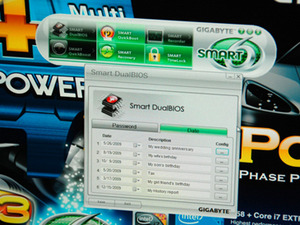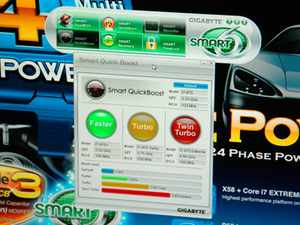
COMPUTEX 2009: Trusted Platform Module – TPM for short – was a controversial technology when first introduced, accused of being a Trojan horse for all kinds of nasty DRM, remote censorship and snooping software. The furore has died down somewhat, in part because TPM-equipped motherboards have settled into boring lives in business PCs, encrypting spreadsheets.
At this year’s Computex show, Gigabyte was keen to show off P55 motherboards with TPM chips, and to explain that the TPM could be useful for consumers. The company’s Smart TPM technology uses Bluetooth to connect the motherboard’s TPM chip and your phone, so they can exchange a 2,048-bit encryption key.
When your phone is within range of the PC, you have access to your designated files – in the demo of the GA-EP55-UD4P board, we saw a drive appear and disappear in ‘My Computer’ when the Product Manager brought his mobile phone intro range.
And the use of this? Hiding your pr0n, of course.
We were also then treated to a demo of Gigabyte’s new Smart6 software, which will come bundled with new motherboards. Apps included with motherboards usually have the ease-of-use and UI design of the controls in a Klingon Bird of Prey; from what we saw Smart6 is compact, simple and straightforward.
As the name implies, there are six functions:


At this year’s Computex show, Gigabyte was keen to show off P55 motherboards with TPM chips, and to explain that the TPM could be useful for consumers. The company’s Smart TPM technology uses Bluetooth to connect the motherboard’s TPM chip and your phone, so they can exchange a 2,048-bit encryption key.
When your phone is within range of the PC, you have access to your designated files – in the demo of the GA-EP55-UD4P board, we saw a drive appear and disappear in ‘My Computer’ when the Product Manager brought his mobile phone intro range.
And the use of this? Hiding your pr0n, of course.
We were also then treated to a demo of Gigabyte’s new Smart6 software, which will come bundled with new motherboards. Apps included with motherboards usually have the ease-of-use and UI design of the controls in a Klingon Bird of Prey; from what we saw Smart6 is compact, simple and straightforward.
As the name implies, there are six functions:
- Smart Quickboost – ‘One click’, instant overclocking.
- Smart DualBIOS – Allows you to store sensitive information securely in the BIOS. In the demo this included both your wife's birthday, and your girlfriend's birthday.
- Smart Quickboot – If you have a stable hardware configuration, some boot-up checks can be skipped, which enables the system to start faster.
- Smart TimeLock – Allows you to determine when the PC will turn on and off.
- Smart Recorder – Allows you to turn on various logging functions, so the PC can record when it’s turned on and off, and even which files are used.
- Smart Recover – Imagine this as some kind of machine which enables you to travel through time and recover old files. Essentially it creates incremental back-ups, in much the same way as Apple’s Time Machine, although it saves space by only focussing on your document directories.



MSI MPG Velox 100R Chassis Review
October 14 2021 | 15:04








Want to comment? Please log in.